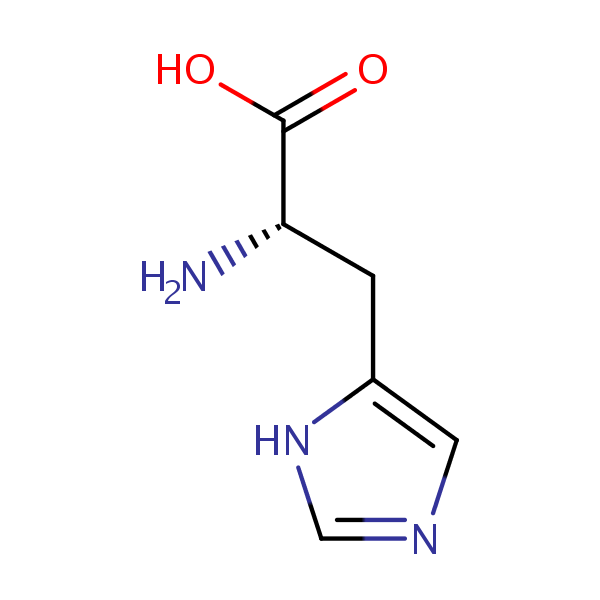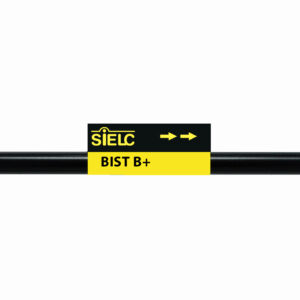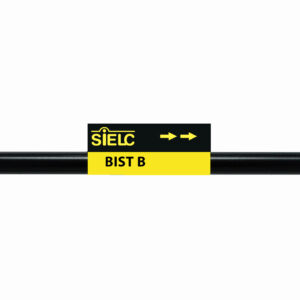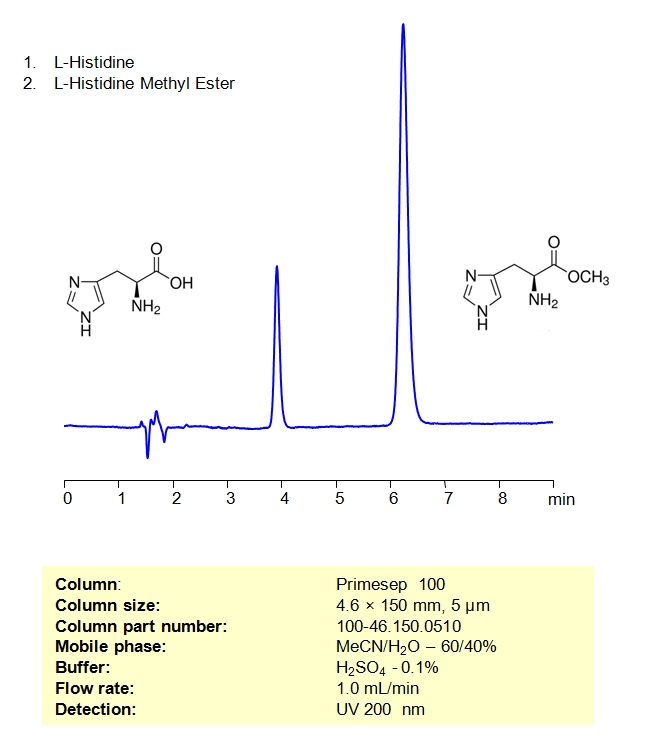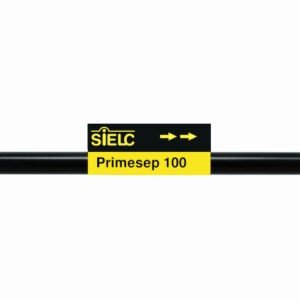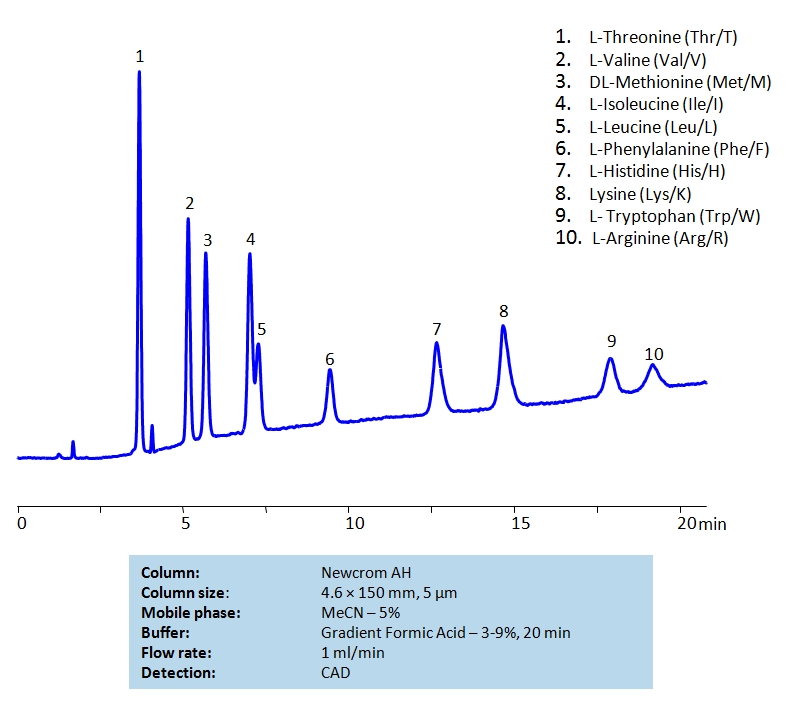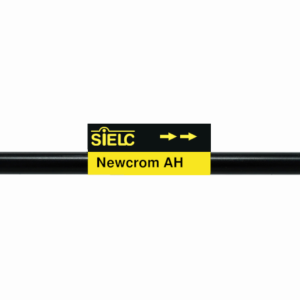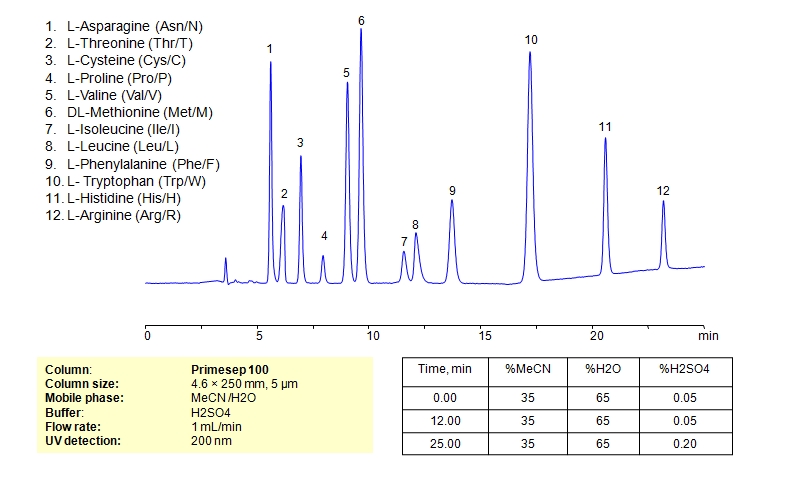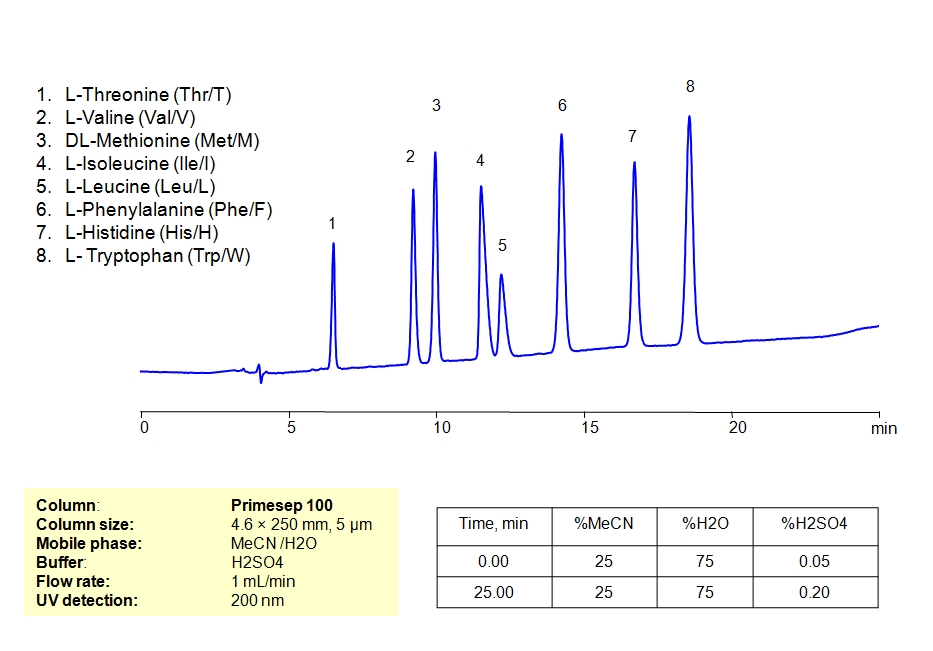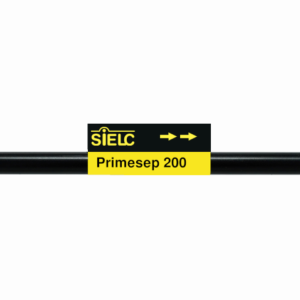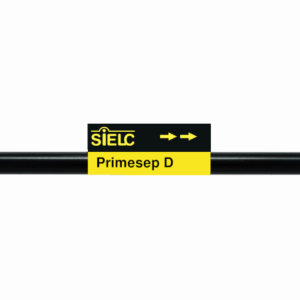| CAS Number | 71-00-1 |
|---|---|
| Molecular Formula | C6H9N3O2 |
| Molecular Weight | 155.157 |
| InChI Key | HNDVDQJCIGZPNO-YFKPBYRVSA-N |
| LogP | -3.32 |
| Synonyms |
|
Applications:
HPLC Method for Separation of Histidine, Histidine Methyl Ester and Histidine lauryl Ester on BIST B+ Column
March 23, 2023
HPLC Method for Separation of Histidine, Histidine Methyl Ester, and Histidine Lauryl Ester on BIST B+ by SIELC Technologies
Separation type: Bridge Ion Separation Technology, or BIST™ by SIELC Technologies
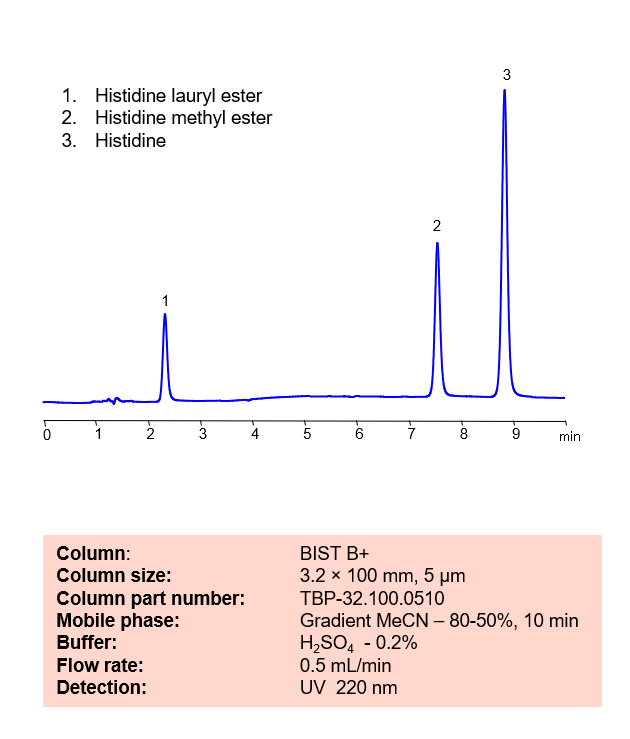
Histidine is a naturally occurring essential amino acid that the body uses to repair damaged tissue and generate new blood cells. Histidine Methyl Ester is a histidine decarboxylase inhibitor and can be used to synthesize other biological compounds. Histidine Lauryl Ester is another derivative of Histidine. Using SIELC’s newly introduced BIST™ method, Histidine and its derivatives can be retained and separated on a positively charged, anion-exchange BIST™ B+ column. There are two keys to this retention method: 1) a multi-charged, negative buffer, such as Sulfuric acid (H2SO4), which acts as a bridge, linking the positively charged dipeptide to the positively charged column surface and 2) a mobile phase consisting mostly of organic solvent (such as MeCN) to minimize the formation of a solvation layer around the charged analytes. Using this new and unique analysis method, Histidine and its derivatives can be UV detected at 220 nm.
High Performance Liquid Chromatography (HPLC) Method for Analysis of Histidine, Histidine Methyl Ester and Histidine lauryl Ester
Condition
| Column | BIST B+, 3.2 x 100 mm, 5 µm, 100 A |
| Mobile Phase | Gradient MeCN – 80 – 50%, 10 min |
| Buffer | H2SO4 – 0.2% |
| Flow Rate | 0.5 ml/min |
| Detection | UV 220 nm |
| Peak Retention Time | 2.2 min, 7.5 min, 8.9 min |
Description
| Class of Compounds | Amino acid |
| Analyzing Compounds | Histidine methyl ester, Histidine |
Application Column
Histidine methyl ester

HPLC Method for Analysis of Arginine, Lysine and Histidine Amino Acids on BIST B+
November 30, 2022
HPLC Method for Analysis of Arginine, Lysine and Histidine Amino Acids on BIST B+ by SIELC Technologies.
Separation type: Bridge Ion Separation Technology, or BIST™ by SIELC Technologies
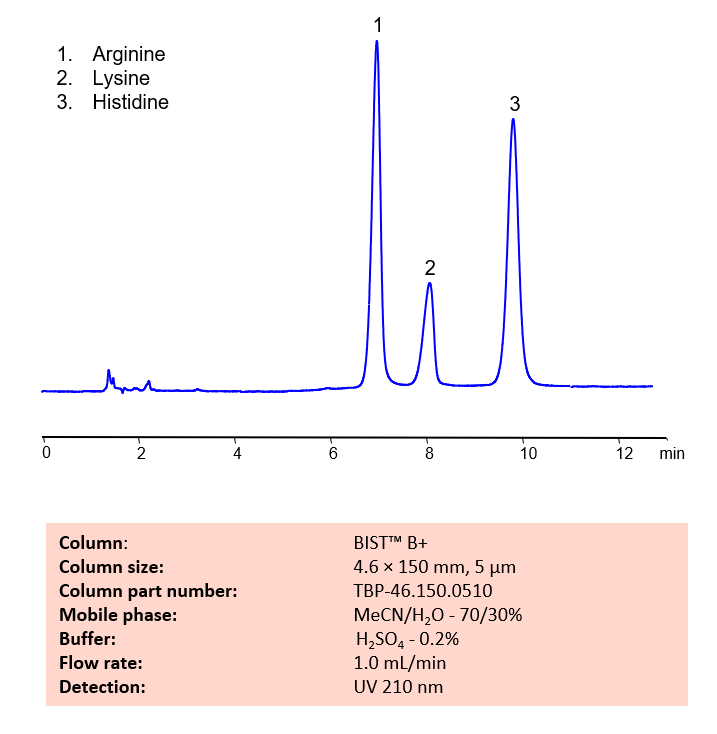
High Performance Liquid Chromatography (HPLC) Method for Analyses of Arginine, Lysine and Histidine Amino Acids
Basic amino acids, like Arginine, Lysine, and Histidine, can be difficult to separate and retain in typical reverse-phase chromatography. Arginine is a naturally-occurring, essential amino acid typically found in meat, poultry, and fish. Lysine is another essential amino acid typically found in meat, and also cereal grains. A third essential amino acid, Histidine, is also typtically found in meat, poultry, and also cereal grains (like rice, wheat, and rye). Using SIELC’s newly introduced BIST™ method, these three essential amino acids, which protonate in water, can be retained on a positively-charged anion-exchange BIST™ B column. There are two keys to this retention method: 1) a multi-charged, negative buffer, such as Sulfuric acid (H2SO4), which acts as a bridge, linking the positively-charged amino acid analytes to the positively-charged column surface and 2) a mobile phase consisting mostly of organic solvent (such as MeCN) to minimize the formation of a solvation layer around the charged analytes. Using this new and unique analysis method, Arginine, Lysine, and Histidine can be retained and UV detected at 210 nm.
Condition
| Column | BIST B+, 4.6×150 mm, 5 µm, 100A |
| Mobile Phase | MeCN – 70% |
| Buffer | H2SO4 – 0.2% |
| Flow Rate | 1.0 ml/min |
| Detection | UV 210 nm |
| Peak Retention Time | 6.2, 8.0, 9.9 min |
Description
| Class of Compounds | Amino acid |
| Analyzing Compounds | Arginine, Lysine, Histidine |
Application Column
BIST B
BIST™ columns offer a unique and effective way to achieve separations that were traditionally challenging or even impossible with other HPLC columns. With the use of a special mobile phase, these ion exchange columns provide very strong retention for analytes with the same charge polarity as the stationary phase, unlocking new chromatography applications. What makes BIST™ columns stand out is their proprietary surface chemistry, which results in superior selectivity, resolution, and sensitivity. These columns offer a simple, efficient solution for a variety of analytical challenges, making them an excellent choice for researchers and analysts across many different fields. To learn more about the technology that powers BIST™ columns and to explore related applications, check out https://BIST.LC.
Select optionsBIST B+
BIST™ columns offer a unique and effective way to achieve separations that were traditionally challenging or even impossible with other HPLC columns. With the use of a special mobile phase, these ion exchange columns provide very strong retention for analytes with the same charge polarity as the stationary phase, unlocking new chromatography applications. What makes BIST™ columns stand out is their proprietary surface chemistry, which results in superior selectivity, resolution, and sensitivity. These columns offer a simple, efficient solution for a variety of analytical challenges, making them an excellent choice for researchers and analysts across many different fields. To learn more about the technology that powers BIST™ columns and to explore related applications, check out https://BIST.LC.
Select optionsHistidine
Lysine

HPLC Method For Analysis Of Histidine and Histidine Methyl Ester Dihydrochloride on Primesep 100 Column
January 27, 2022
Separation type: Liquid Chromatography Mixed-mode
High Performance Liquid Chromatography (HPLC) Method for Analysis of Histidine and Histidine Methyl Ester Dihydrochloride
Histidine and Histidine Methyl Ester Dyhydrochloride are related compounds with interesting uses. Histidine is used in biosynthesis to create proteins, while histidine methyl ester dihydrochloride (a derivative of histidine) is used to create various other compounds.
This amino acid and its derivative can be detected in the low UV regime. Using a Primesep 100 mixed-mode column and a mobile phase consisting of water and acetonitrile (MeCN) with a sulfuric acid (H2SO4) buffer, Histidine and Histidine Methyl Ester Dyhydrochloride can be retained, separated, and analyzed. This analysis method can be UV detected at 200 nm.
| Column | Primesep 100, 4.6×150 mm, 5 µm, 100A |
| Mobile Phase | MeCN/H2O – 60/40% |
| Buffer | H2SO4 – 0.1% |
| Flow Rate | 1.0 ml/min |
| Detection | UV, 200 nm |
| Class of Compounds |
Amino acid |
| Analyzing Compounds | Histidine, Histidine Methyl Ester |
Application Column
Primesep 100
The Primesep family of mixed-mode columns offers a wide variety of stationary phases, boasting unprecedented selectivity in the separation of a broad array of chemical compounds across multiple applications. Corresponding Primesep guard columns, available with all stationary phases, do not require holders. SIELC provides a method development service available to all customers. Inquire about our specially-tailored custom LC-phases for specific separations.
Select optionsHistidine methyl ester
L-Histidine hydrochloride monohydrate

HPLC Separation of Mixture of Nine Essential Amino acids and Arginine on Newcrom AH Column
September 25, 2020
Essential amino acids cannot be made by the body. As a result, they must come from food.
The 9 essential amino acids are: histidine, isoleucine, leucine, lysine, methionine, phenylalanine, threonine, tryptophan, and valine.
| Column | Newcrom AH, 4.6×150 mm, 5 µm, 100A |
| Mobile Phase | MeCN – 5% |
| Buffer | Gradient Formic Acid – 3-9%, 20 min |
| Flow Rate | 1.0 ml/min |
| Detection | CAD |
| Class of Compounds |
Drug, Acid, Hydrophilic, Ionizable, Vitamin, Supplements, Amino acid |
| Analyzing Compounds | L-Threonine (Thr/T), L-Valine (Val/V), DL-Methionine (Met/M), L-Isoleucine (Ile/I), L-Leucine (Leu/L), L-Phenylalanine (Phe/F), L-Histidine (His/H), Lysine (Lys/K) , L- Tryptophan (Trp/W), L-Arginine (Arg/R) |
Application Column
Newcrom AH
The Newcrom columns are a family of reverse-phase-based columns. Newcrom A, AH, B, and BH are all mixed-mode columns with either positive or negative ion-pairing groups attached to either short (25 Å) or long (100 Å) ligand chains. Newcrom R1 is a special reverse-phase column with low silanol activity.
Select optionsHistidine
Isoleucine
L-Threonine
Leucine
Lysine
Methionine
Phenylalanine
Tryptophan
Valine

HPLC Separation of Mixture of 12 Amino Acids on Primesep 100 Column
March 11, 2019
| Column | Primesep 100, 4.6×250 mm, 5 µm, 100A |
| Mobile Phase | MeCN/H2O – 35/65% |
| Buffer | H2SO4 0.05% 12 min hold, gradient 0.05-0.20, 13 min |
| Flow Rate | 1.0 ml/min |
| Detection | UV, 200 nm |
| Class of Compounds |
Drug, Acid, Hydrophilic, Ionizable, Vitamin, Supplements, Amino acid |
| Analyzing Compounds | L-Asparagine (Asn/N), L-Threonine (Thr/T), L-Cysteine (Cys/C), L-Proline (Pro/P), L-Valine (Val/V), DL-Methionine (Met/M), L-Isoleucine (Ile/I), L-Leucine (Leu/L), L-Phenylalanine (Phe/F), L- Tryptophan (Trp/W), L-Histidine (His/H), L-Arginine (Arg/R) |
Application Column
Primesep 100
The Primesep family of mixed-mode columns offers a wide variety of stationary phases, boasting unprecedented selectivity in the separation of a broad array of chemical compounds across multiple applications. Corresponding Primesep guard columns, available with all stationary phases, do not require holders. SIELC provides a method development service available to all customers. Inquire about our specially-tailored custom LC-phases for specific separations.
Select optionsArginine
Asparagine
Cysteine
D-Isoleucine
D-Leucine
D-Valine
DL-Isoleucine
Histidine
Isoleucine
L-Cysteine
L-Methionine
L-Threonine
Leucine
Methionine
Phenylalanine
Proline
Tryptophan
Valine

HPLC Separation of Mixture of Essential Amino Acids on Primesep 100 Column
March 11, 2019
| Column | Primesep 100, 4.6×250 mm, 5 µm, 100A |
| Mobile Phase | MeCN/H2O – 25/75% |
| Buffer | Gradient H2SO4 0.05-0.2% 25 min |
| Flow Rate | 1.0 ml/min |
| Detection | UV, 200 nm |
| Class of Compounds |
Drug, Acid, Hydrophilic, Ionizable, Vitamin, Supplements, Amino acid |
| Analyzing Compounds | L-Threonine (Thr/T), L-Valine (Val/V), DL-Methionine (Met/M), L-Isoleucine (Ile/I), L-Leucine (Leu/L), L-Phenylalanine (Phe/F), L-Histidine (His/H), L- Tryptophan (Trp/W) |
Application Column
Primesep 100
The Primesep family of mixed-mode columns offers a wide variety of stationary phases, boasting unprecedented selectivity in the separation of a broad array of chemical compounds across multiple applications. Corresponding Primesep guard columns, available with all stationary phases, do not require holders. SIELC provides a method development service available to all customers. Inquire about our specially-tailored custom LC-phases for specific separations.
Select optionsD-Isoleucine
D-Leucine
D-Valine
DL-Isoleucine
Histidine
Isoleucine
L-Histidine hydrochloride monohydrate
L-Isoleucine
L-Methionine
L-Threonine
Methionine
Phenylalanine
Tryptophan
Valine

HPLC Separation of Amino Acids in Zero Organic Mode on Primesep 200 column
July 8, 2011
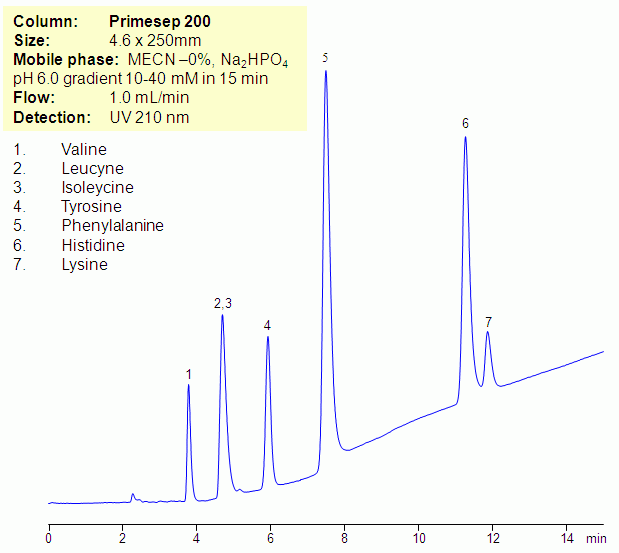
Essential and non-essential amino acids can be retained and separated in zero-organic mode on Primesep mixed-mode HPLC columns. Zero-organic mode is required to monitor isotopes of carbon. Amino acids are retained by combination of reversed-phase and cation-exchange mechanisms. At lower pH, some of the amino acids are more hydrophobic. Buffer pH will affect ionization state of amino acids, and at higher pH (above 2.5), the amino acids will be less hydrophobic and retentive in zero-organic mode. Amino acids can be monitored by low UV. Method can be used in archeological research for analysis of various molecules where presence of organic component of the mobile phase interferes with analysis.
| Column | Primesep 200, 4.6×250 mm, 5 µm, 100A |
| Mobile Phase | MeCN/H2O |
| Buffer | Na2HPO4 |
| Flow Rate | 1.0 ml/min |
| Detection | UV 210 nm |
| Class of Compounds |
Drug, Acid, Hydrophilic, Ionizable, Vitamin, Supplements |
| Analyzing Compounds | Valine, Leucyne, Isoleycine, Tyrosine, Phenylalanine, Histidine, Lysine |
Application Column
Primesep 200
The Primesep family of mixed-mode columns offers a wide variety of stationary phases, boasting unprecedented selectivity in the separation of a broad array of chemical compounds across multiple applications. Corresponding Primesep guard columns, available with all stationary phases, do not require holders. SIELC provides a method development service available to all customers. Inquire about our specially-tailored custom LC-phases for specific separations.
Select optionsIsoleucine
Leucine
Lysine
Phenylalanine
Tyrosine
Valine

HPLC Analysis of Polysorbate in Mixture with Amino Acids and Sugar
July 16, 2009
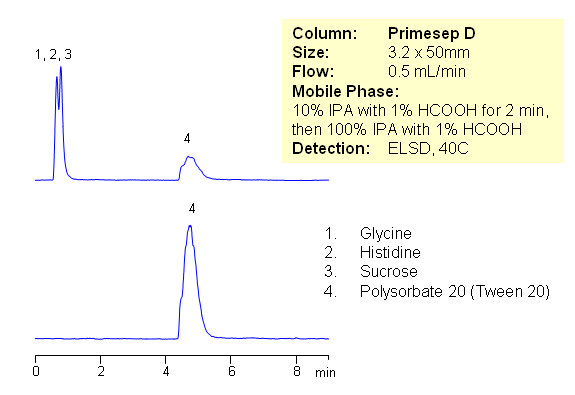
Polysorbates are a class of emulsifiers used in some pharmaceuticals and food preparation. They are often used in cosmetics to solubilize essential oils into water-based products. Polysorbates are oily liquids derived from PEG-ylated sorbitan (a derivative of sorbitol) esterified with fatty acids. Surfactants that are esters of plain (non-PEG-ylated) sorbitan with fatty acids are usually referred to by the name Span. It is often required to quantitate Polysorbate (Polysorbate/Tween 20, Polysorbate/Tween 40, Polysorbate 60/Tween 60 and Polysorbate 80) by HPLC in various formulations. Polysorbates exist in form of oligomers.
| Column | Primesep D, 3.2×50 mm, 5 µm, 100A |
| Mobile Phase | IPA |
| Buffer | Formic Acid |
| Flow Rate | 0.5 ml/min |
| Detection | ELSD |
| Class of Compounds |
Drug, Acid, Hydrophilic, Ionizable, Vitamin, Supplements, Amino acid |
| Analyzing Compounds | Glycine, Histidine, Sucrose, Polysorbate 20 |
Application Column
Primesep D
The Primesep family of mixed-mode columns offers a wide variety of stationary phases, boasting unprecedented selectivity in the separation of a broad array of chemical compounds across multiple applications. Corresponding Primesep guard columns, available with all stationary phases, do not require holders. SIELC provides a method development service available to all customers. Inquire about our specially-tailored custom LC-phases for specific separations.
Select optionsGlycine
Histidine
Polysorbate
Polysorbate 20
Polysorbate 80
Sucrose
Tween 20
Tween 80

Amino Acids Analysis in Acid Gradient Condition
September 18, 2006
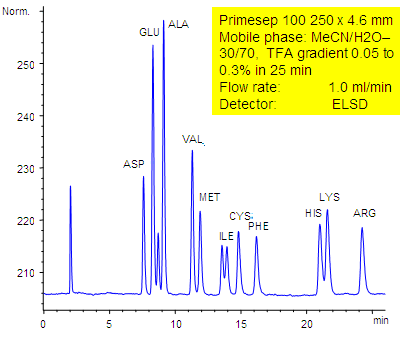
11 underivatized amino acids (aspartic acid, glutamic acid, alanine, valine, methionine, isoleucine, cysteine, phenylalanine, histidine, lysine, and arginine) are separated by a Primesep 100 HPLC column by reversed-phase and ion-exchange mechanisms with LC/MS compatible conditions without the use of ion-pair reagents. The HPLC separation uses a TFA (trifluoroacetic acid) gradient in a mobile phase of water acetonitrile (MeCN, ACN with evaporative light scattering detection (ELSD).
| Column | Primesep 100, 4.6×250 mm, 5 µm, 100A |
| Mobile Phase | MeCN/H2O – 30/70% |
| Buffer | TFA , gradient 0.05-0.3 % , 25 min |
| Flow Rate | 1.0 ml/min |
| Detection | ELSD |
| Class of Compounds |
Drug, Acid, Hydrophilic, Ionizable, Vitamin, Supplements |
| Analyzing Compounds | Aspartic acid, Glutamic acid, Alanine, Valine, Methionine, Isoleucine, Cysteine, Phenylalanine, Histidine, Lysine, Arginine |
Application Column
Primesep 100
The Primesep family of mixed-mode columns offers a wide variety of stationary phases, boasting unprecedented selectivity in the separation of a broad array of chemical compounds across multiple applications. Corresponding Primesep guard columns, available with all stationary phases, do not require holders. SIELC provides a method development service available to all customers. Inquire about our specially-tailored custom LC-phases for specific separations.
Select optionsAmino Acids
Arginine
Aspartic Acid
Cysteine
Glutamic Acid
Histidine
Isoleucine
Lysine
Methionine
Phenylalanine
Valine

HPLC Separation of Creatine, Creatinine and Histidine with MS Conditions
January 13, 2005
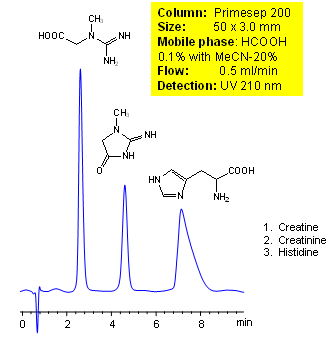
Creatine, creatinine, and histidine are all important amino acids in the human body. All of these can be separated by liquid chromatography. The mobile phase contains acetonitrile (MeCN), water, and phormic acid. Smaller 3 µm particle columns are available for fast UPLC applications. This liquid chromatography method is scalable and can be used for isolation of impurities in preparative separation. It also suitable for pharmacokinetics.
| Column | Primesep 200, 3.0×150 mm, 5 µm, 100A |
| Mobile Phase | MeCN/H2O – 20/80% |
| Buffer | Formic Acid – 0.1% |
| Flow Rate | 0.5 ml/min |
| Detection | UV, 210 nm |
| Class of Compounds |
Drug, Acid, Hydrophilic, Ionizable, Hormone |
| Analyzing Compounds | Creatine, Creatinine, Histidine |
Application Column
Primesep 200
The Primesep family of mixed-mode columns offers a wide variety of stationary phases, boasting unprecedented selectivity in the separation of a broad array of chemical compounds across multiple applications. Corresponding Primesep guard columns, available with all stationary phases, do not require holders. SIELC provides a method development service available to all customers. Inquire about our specially-tailored custom LC-phases for specific separations.
Select optionsCreatinine
Histidine

HPLC Separation of Creatine, Creatinine and Histidine
January 13, 2005
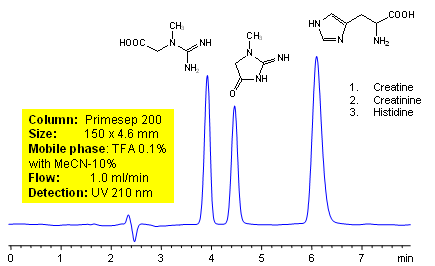
Creatine is produced by the body and plays a major role in recycling ATP. It also stabilizes pH in certain tissues. Creatine can be analyzed by this reverse phase (RP) HPLC method with simple conditions. The mobile phase contains acetonitrile (MeCN), water, and TFA. For Mass-Spec (MS) compatible applications the phosphoric acid needs to be replaced with formic acid. Smaller 3 µm particle columns are available for fast UPLC applications. This liquid chromatography method is scalable and can be used for isolation of impurities in preparative separation. It also suitable for pharmacokinetics.
| Column | Primesep 200, 4.6×150 mm, 5 µm, 100A |
| Mobile Phase | MeCN/H2O – 1/90% |
| Buffer | TFA -0.1% |
| Flow Rate | 1.0 ml/min |
| Detection | UV, 210 nm |
| Class of Compounds |
Drug, Acid, Hydrophilic, Ionizable, Hormone |
| Analyzing Compounds | Creatine, Creatinine, Histidine |
Application Column
Primesep 200
The Primesep family of mixed-mode columns offers a wide variety of stationary phases, boasting unprecedented selectivity in the separation of a broad array of chemical compounds across multiple applications. Corresponding Primesep guard columns, available with all stationary phases, do not require holders. SIELC provides a method development service available to all customers. Inquire about our specially-tailored custom LC-phases for specific separations.
Select optionsCreatinine
Histidine

